What is Elasticity of Supply?
Elasticity of supply is a measure of the degree of change in the quantity supplied of a product in response to a change in its price.

Table of Content
- 1 What is Elasticity of Supply?
- 2 Elasticity of Supply Definition
- 3 Elasticity of Supply Formula
- 4 Elasticity of Supply Example
- 5 Types of Elasticity of Supply
- 6 Measurement of Elasticity of Supply
- 7 Determinants of Elasticity of Supply
- 8 Business Economics Tutorial
As discussed previously, the law of supply states that the quantity supplied of a product increases with a rise in the price of the product and vice versa, while keeping all other factors constant.
However, an organisation needs to determine the impact of change in the price of a product on its supply in numerical terms. The concept of elasticity of supply helps organisations to estimate the impact of change in the supply of a product with respect to its price.
Elasticity of Supply Definition
Also Read: Price Elasticity of Demand
Elasticity of Supply Formula
Mathematically, the elasticity of supply is expressed as:
Percentage change in quantity supplied =

Percentage change in quantity supplied =

The elasticity of supply can be calculated with the help of the following formula:
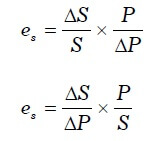
Where,
ΔS = S1 – S
ΔP = P1 – P
Elasticity of Supply Example
Let us understand how to calculate the elasticity of supply with the help of an example.
Example: Assume that a business firm supplied 450 units at the price of 4500. The firm has decided to increase the price of the product to> 5500. Consequently, the supply of the product is increased to 600 units. Calculate the elasticity of supply.
Solution: Here,
P = 4500 ΔP = 1000 (a fall in price; 5500– 4500 = 1000)
S = 450 units
ΔS = 150 (600 – 450)
By substituting these values in the above formula, we get:
es = 150/1000 x 4500/450 = 1.5
Types of Elasticity of Supply
Similar to elasticity of demand, elasticity of supply also does not remain same. The degree of change in the quantity supplied of a product with respect to a change in its price varies under different situations.
Based on the rate of change, the types of price elasticity of supply is grouped into five main categories as follows:
- Perfectly elastic supply
- Perfectly Inelastic Supply
- Relatively Elastic Supply
- Relatively Inelastic Supply
- Unitary Elastic Supply
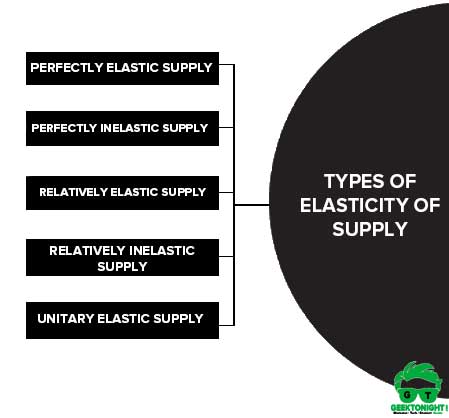
Perfectly elastic supply
When a proportionate change (increase/ decrease) in the price of a product results in an increase/decrease of quantity supplied, it is called a perfectly elastic supply.
In such a case, the numerical value of elasticity of supply would be infinite (es =∞). This situation is imaginary as there is no such product whose supply is perfectly elastic.
Therefore, this situation does not have any practical implication.
Perfectly elastic supply example
Let us understand the concept of a perfectly elastic supply with the help of an example.
Example: The supply schedule of product X is given as follows:
| Price (₹ Per Kg.) | Quantity Supplied (Kgs. in thousands) |
|---|---|
| 100 | 40 |
| 100 | 60 |
| 100 | 80 |
Draw a supply curve for the supply schedule and find the type of elasticity of supply using the curve.
Solution: The supply curve for product X is shown in Figure.
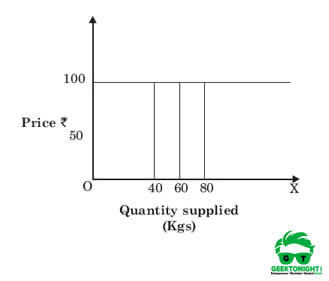
Figure shows that the price of product X remains constant at ₹100 per kg. However, the quantity supplied changes from 40,000 kgs to 80,000 kgs at the same price. Therefore, the supply of product X is perfectly elastic ( es =∞).
Perfectly Inelastic Supply
In this situation, the quantity supplied does not change with respect to a proportionate change in the price of a product.
In other words, the quantity supplied remains constant at the change in price when supply is perfectly inelastic.
Thus, the elasticity of supply is equal to zero ( es =0). However, this situation is imaginary as there can be no product whose supply could be perfectly inelastic.
Perfectly inelastic supply example
Let us understand the concept of perfectly inelastic supply with the help of an example.
Example: The quantity supplied and the price of product A are given as follows:
| Price (₹ Per Kg.) | Quantity Supplied (Kgs. in thousands) |
|---|---|
| 45 | 50 |
| 55 | 50 |
| 65 | 50 |
Draw a supply curve for the supply schedule and find the type of elasticity of supply using the curve.
Solution: The supply curve for product A is shown in Figure
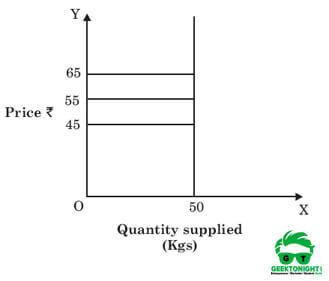
Figure, shows that the supply of product A remains constant at 50,000 kgs. However, the price changes from 45 to 65 at the same supply rate. Therefore, the supply of product X is perfectly inelastic (e = 0).
Relatively Elastic Supply
When a percentage change in the quantity supplied is more than a percentage change in the price of a product, it is called relatively elastic supply.
In this case, the elasticity of supply is less than 1, i.e. es < 1.
Relatively elastic supply example
Let us understand the concept of relatively elastic supply with the help of an example.
Example: The quantity supplied and the price of product P are given as follows:
| Price (₹ Per Kg.) | Quantity Supplied (Kgs. in thousands) |
|---|---|
| 50 | 35 |
| 53 | 40 |
| 55 | 45 |
Draw a supply curve for the supply schedule of product P and find the type of the elasticity of supply using the curve.
Solution: The supply curve for product P is shown in Figure
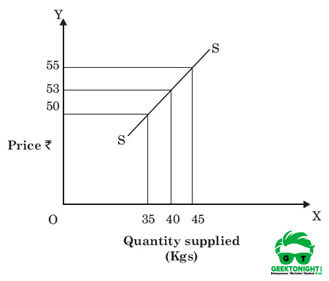
In Figure, SS is the supply curve. When the price of product P is 50, the quantity supplied is 35,000 kgs. However, when the price increases to 53, supply reaches to 40,000 kgs.
Similarly, when the price further increases to 55, the supply increases to 45,000 kgs. This shows that the change in price is only 2 while the change in supply is 5,000 kgs.
In other words, the proportionate change in quantity supplied is more than the proportionate change in the price of product P.
Therefore, the supply of product P is highly elastic (es>1).
Relatively Inelastic Supply
When a percentage change in the quantity supplied is less than the percentage change in the price of a product, it is called relatively inelastic supply.
In this case, the elasticity of supply is greater than 1, i.e. es < 1.
Relatively inelastic supply example
Let us understand the concept of relatively inelastic supply with the help of an example.
Example: The quantity supplied and the price of product B are given as follows:
| Price (₹ Per Kg.) | Quantity Supplied (Kgs. in thousands) |
|---|---|
| 45 | 50 |
| 55 | 51 |
| 65 | 52 |
Draw a supply curve for the supply schedule of product B and find the type of elasticity of supply using the curve.
Solution: The supply curve for product B is given in Figure
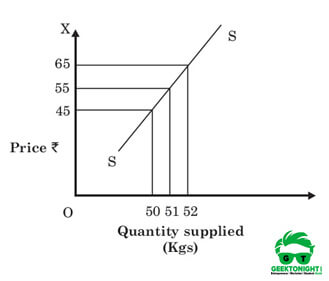
In Figure, when the price of product B is 45, the quantity supplied is 50,000 kgs. When price increases to 55, supply reaches to 51,000 kgs.
Similarly, as the price of product B increases to 65, the supply increases to 52,000 kgs, which clearly shows that a change in price is 10 while the change in supply is 1,000 kgs.
In other words, the proportionate change in quantity supplied is less than the change in the price of product B. Thus, the supply of product B is relatively inelastic ( es <1).
Unitary Elastic Supply
When the proportionate change in the quantity supplied is equal to the proportionate change in the price of a product, the supply is unitary elastic.
In this case, elastic supply is equal to one ( es =1).
Unitary elastic supply example
Let us understand the concept of relatively elastic supply with the help of an example.
Example: The quantity supplied and the price of product Z are given below:
| Price (₹ Per Kg.) | Quantity Supplied (Kgs. in thousands) |
|---|---|
| 50 | 30 |
| 55 | 35 |
| 65 | 52 |
Solution: The supply curve for product Z is shown in Figure
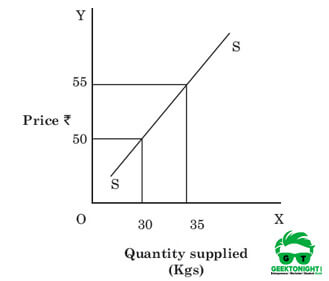
In Figure, when the price of product Z is 50, the quantity supplied is 30,000 kgs. When price increases to 55, supply reaches to 35,000 kgs. This shows that the proportionate change in quantity supplied is equal to the change in the price of product Y. Therefore, the supply of product B is unit elastic ( es =1).
Also Read: Law of Diminishing Marginal Utility
Measurement of Elasticity of Supply
An organisation is required to estimate the elasticity of supply for making various business decisions under different situations, such as deciding the supply of products. Apart from this, the concept of elasticity of supply is helpful for the government in deciding taxation policies.
For instance, high taxes are levied on goods whose supply is inelastic to generate large revenues. Thus, a numerical value is required to measure the elasticity of supply.
There are two most commonly used methods for measuring the elasticity of supply, which are explained as follows:
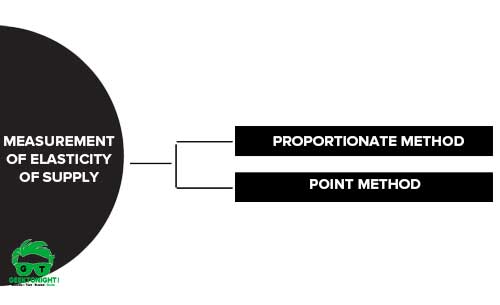
Proportionate method
It is an important method of measuring the elasticity of supply. In this method, the elasticity of supply is calculated by dividing the percentage change in quantity supplied with the percentage change in the price of a product.
Thus, the elasticity of supply is calculated as follows:

Percentage change in quantity supplied =

Percentage change in price = Change in price (ΔS) / Original price (P)

Where
ΔS = S1–S
ΔP = P1–P
Point method
In this method, the elasticity of supply is measured at a particular point on the supply curve. For that, a tangent needs to be drawn along with the demand curve. Let us understand the estimation of elasticity of supply on the demand curve using the point method.
In Figure, TF is a tangent drawn from point P to measure the elasticity of supply. This tangent intersects X-axis at point T. Another vertical line from P is intersecting X-axis at point B. Thus, the elasticity of supply at point P is calculated as:
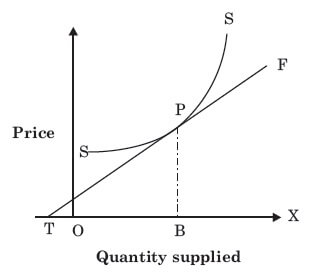
In Figure, TF is a tangent drawn from point P to measure the elasticity of supply. This tangent intersects X-axis at point T. Another vertical line from P is intersecting X-axis at point B. Thus, the elasticity of supply at point P is calculated as:
es = TB/OB
Thus, it presents three conditions. If
TB > OB, es > 1
TB < OB, es <1
TB = OB, es = 1
Let us understand these three conditions with the help of the following diagrams:
1. When TB < OB
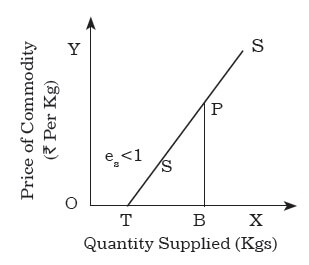
In Figure, SS is the supply curve and at point P the elasticity of the supply is measured. When SS curve is extended, it intersects OX axis at point T. Now es is represented as TB/OB
By seeing the Figure, it is apparent that TB < OB. Therefore, es < 1, a representative that the supply is less inelastic:
2. When TB = OB
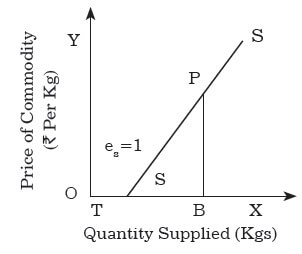
In Figure, SS is the supply curve and at point P the elasticity of the supply is measured. As SS curve is extended, passes through the point of origin. Now es is represented as
By seeing Figure, it is apparent that TB = OB. Therefore, es = 1, implying that the supply is elastic:
3. When TB > OB
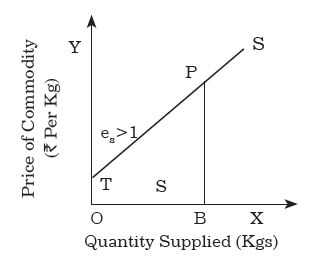
In Figure, SS is the supply curve and at point P the elasticity of the supply is measured. As SS curve is extended, it meets OY axis at point T. Now es is represented as
By seeing Figure, it is apparent that TB>OB. Therefore, es > 1, implying that the supply is highly elastic.
Also Read: Types of Market Structures
Determinants of Elasticity of Supply
The elasticity of supply cannot be the same under all circumstances. This is because it is influenced by a number of factors. Some of the important factors affecting elasticity of supply are explained as follows:
Determinants of Elasticity of Supply
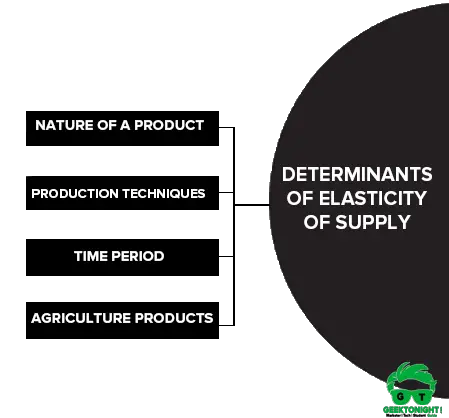
Nature of a product
The product’s nature is an important factor that influences the elasticity of supply. For instance, products that are perishable in nature have inelastic supply as their supply cannot be increased or decreased in a short span of time. On the other hand, products, such as antiques and old wines, which cannot be reproduced in the same form, have a constant supply.
Production techniques
Production techniques used by organisations also have a great influence on the supply of their products. If organisations use the latest techniques of production, the supply can be faster with respect to the change in the price of products.
Time period
It affects the elasticity of supply to a great extent. For instance, in the short run, elasticity of supply is low due to various factors, such as obsolete production techniques. Therefore, changes in prices do not affect the supply of products immediately. If the price remains high for a longer period, the supply of products is increased.
Agriculture products
The production of agriculture products cannot be increased or decreased easily as they depend on natural factors, including rain, humidity, and sunlight. This affects the supply of such products to a great extent; thereby making the supply relatively inelastic.
Also Read: Price Ceiling and Price Floor
Business Economics Tutorial
(Click on Topic to Read)
Go On, Share article with Friends
Did we miss something in Business Economics Tutorial? Come on! Tell us what you think about our article on Elasticity of Supply | Business Economics in the comments section.
Business Economics Tutorial
(Click on Topic to Read)












